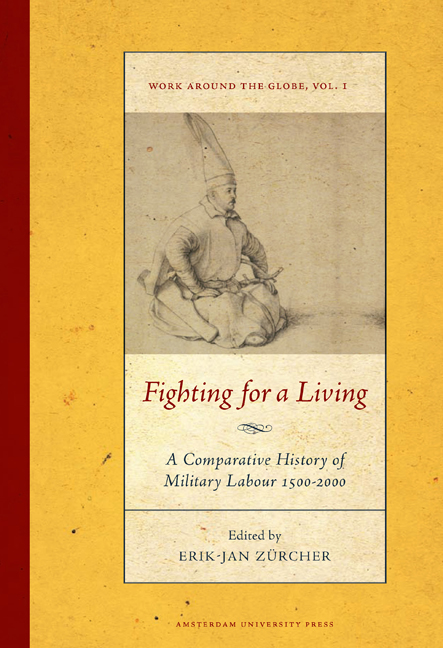Book contents
- Frontmatter
- Dedication
- Contents
- Preface
- Introduction: Understanding Changes in Military Recruitment and Employment Worldwide
- Military Labor in China, c. 1500
- From the Mamluks to the Mansabdars: A Social History of Military Service in South Asia, c. 1500 to c. 1650
- On the Ottoman Janissaries (Fourteenth-nineteenth Centuries)
- Soldiers in Western Europe, c. 1500-17901
- The Scottish Mercenary as a Migrant Labourer in Europe, 1550-1650
- Change and Continuity in Mercenary Armies: Central Europe, 1650-1750
- Peasants Fighting for a Living in Early Modern North India
- “True to Their Salt”: Mechanisms for Recruiting and Managing Military Labour in the Army of the East India Company During the Carnatic Wars in India
- “The Scum of Every County, the Refuse of Mankind”: Recruiting the British Army in the Eighteenth Century
- Mobilization of Warrior Populations in the Ottoman Context, 1750-1850
- Military Employment in Qing Dynasty China
- Military Service and the Russian Social Order, 1649-1861
- The French army, 1789-1914: Volunteers, Pressed Soldiers, and Conscripts
- The Dutch Army in Transition: From All-volunteer Force to Cadre-militia Army, 1795-1830
- The Draft and Draftees in Italy, 1861-1914
- Nation-building, War Experiences, and European Models: The Rejection of Conscription in Britain
- Mobilizing Military Labor in the Age of Total War: Ottoman Conscription Before and During the Great War
- Soldiering as Work: The All-volunteer Force in the United States
- Private Contractors in War From the 1990s to the Present: A Review Essay
- Collective Bibliography
- Notes on Contributors
Military Employment in Qing Dynasty China
Published online by Cambridge University Press: 12 December 2020
- Frontmatter
- Dedication
- Contents
- Preface
- Introduction: Understanding Changes in Military Recruitment and Employment Worldwide
- Military Labor in China, c. 1500
- From the Mamluks to the Mansabdars: A Social History of Military Service in South Asia, c. 1500 to c. 1650
- On the Ottoman Janissaries (Fourteenth-nineteenth Centuries)
- Soldiers in Western Europe, c. 1500-17901
- The Scottish Mercenary as a Migrant Labourer in Europe, 1550-1650
- Change and Continuity in Mercenary Armies: Central Europe, 1650-1750
- Peasants Fighting for a Living in Early Modern North India
- “True to Their Salt”: Mechanisms for Recruiting and Managing Military Labour in the Army of the East India Company During the Carnatic Wars in India
- “The Scum of Every County, the Refuse of Mankind”: Recruiting the British Army in the Eighteenth Century
- Mobilization of Warrior Populations in the Ottoman Context, 1750-1850
- Military Employment in Qing Dynasty China
- Military Service and the Russian Social Order, 1649-1861
- The French army, 1789-1914: Volunteers, Pressed Soldiers, and Conscripts
- The Dutch Army in Transition: From All-volunteer Force to Cadre-militia Army, 1795-1830
- The Draft and Draftees in Italy, 1861-1914
- Nation-building, War Experiences, and European Models: The Rejection of Conscription in Britain
- Mobilizing Military Labor in the Age of Total War: Ottoman Conscription Before and During the Great War
- Soldiering as Work: The All-volunteer Force in the United States
- Private Contractors in War From the 1990s to the Present: A Review Essay
- Collective Bibliography
- Notes on Contributors
Summary
This chapter explores the military structures in China between 1650 and 1900 from the perspective of labour history as devised by the Global Collaboratory on the History of Labour Relations 1500-2000. It will first present the basic structures of the Qing armies. There follows a discussion of the state of the art in research and the major issues and debates in this field. Finally, the authors assess trends and tendencies in the framework of the matrix of hypotheses developed within the research group Fighting for a Living.
The Qing armies, 1600-1911: a short overview
The Manchu Qing dynasty ruled China between 1644 and 1911. It originated from semi-nomadic groups of the Jurchen confederation who lived scattered across the today's north-eastern Chinese provinces of Liaoning, Jilin, and Heilongjiang. These groups defined themselves as ethnically and culturally distinct from their mighty, numerous, and affluent neighbours in the south-west, the Chinese or “Han”, and began to refer to themselves as “Man” or “Manchus”. After 1600, their unifier, Nurhaci (1559-1626), organized his followers into socio-military units or companies. Family members and dependants were also registered in the military households. As far as our knowledge goes, “followers” implies the entire population that had pledged allegiance to Nurhaci, voluntarily or by force. In 1615, these companies were officially divided into the so-called Eight Banners. Not only the Manchus were grouped into these formations, but also Mongols, Koreans, and Chinese who had either lived in the areas north of the Great Wall or had submitted to the Manchus before they started their conquest of China proper in 1644. In 1635, Nurhaci's son and successor Hong Taiji (r. 1626-1643) divided the Banners along ethnic lines, with a Manchu, a Mongol, and a Chinese (the latter also called the “Chinese-martial”) Banner assigned to each of the eight, resulting in an actual number of twenty-four Banners. The Banners were assigned different colours, according to the flags and uniforms they carried into and wore during battle. Their organization was dissolved only after the fall of the Qing dynasty in 1912.
Precise and factual figures are unavailable and are subject to much recent debate. Roughly speaking, the estimates for the entire Banner population, including men, women, children, elderly, and dependants (bondservants and slaves) range between 1.3 million and 2.4 million in 1648, and 2.6 million to 4.9 million in 1720.
- Type
- Chapter
- Information
- Fighting for a LivingA Comparative Study of Military Labour 1500–2000, pp. 353 - 392Publisher: Amsterdam University PressPrint publication year: 2013
- 3
- Cited by

